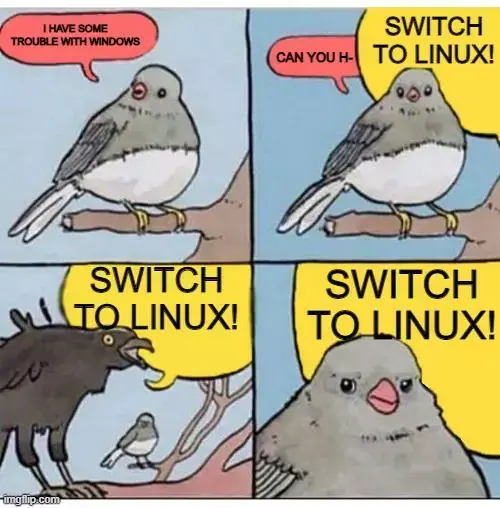- cross-posted to:
- [email protected]
- cross-posted to:
- [email protected]
Pretty exciting times ahead as Valve might finally release SteamOS to more hardware. This amount of Linux desktop coverage would be unimaginable few years ago.
I feel like that’s good for the wrong reasons.
I hope GN complains about how certain things that should have been fixed years ago are still broken because of bike shedding.
It is a weird decision to me though, because as much as I like Linux, the Linux desktop isn’t at all a stable platform. Your experience can be vastly different depending on what distro, mesa version, display server, driver, etc you use. So in a way, I wonder if they’ll bother to show “the best case scenario” or just go with what’s most popular.
Hot take: If they are doing it, they should use what’s most popular and if it’s bad, sh!t on it, as that seems to be the only way to get long standing issues fixed…(look at pop!os and KDE as an example)
Show me a stable windows desktop.(The same applies to Windows.)
deleted by creator
I mean, Windows is undeniably more stable than certain linux configurations. Nothing will ever be 100% stable, but if you compare Windows to basically any rolling release distro, Windows is gonna be more stable. That’s just the nature of the two things.
You say it’s because of configs etc., i.e. problems caused by the user. That is a serious difference. You should also narrow it down to SteamOS, Garuda, Bazzite, CachyOS or one of the other distributions designed for gaming. After all, these are also experiencing the most growth in gaming from people leaving Windows behind.
Windows and stable? So blue screens during OS installation are stable? Windows didn’t catch on because it was stable. It stole the most important thing and then the dirty gag contracts where Intel and Nvidia were also involved. That’s the only reason why this trickery has prevailed. Windows is and always has been rubbish, but MS knew how to damage competitors and secure a monopoly position. Windows and stable are a joke.
Every OS was programmed by humans and contains errors. This does not apply to just one OS or the other. In addition, faulty software also runs on faulty hardware. From this point of view, stable is no longer possible with today’s CPUs, even if you counteract this via microcode.
deleted by creator
What do you have to tinker with first so that you can only install a local account? Or so that the whole thing also runs on older hardware without TPM. People also have to look on the web to see what needs to be fixed during the installation… and then, depending on the version, install Manuel group policies and everything. You also have to fiddle around with Windows, which makes more and more people switch.What do you first have to fiddle around with the OS installation so that you can install with a local account? Or so that the whole thing also runs on older hardware without TPM. People also have to look on the web to see what needs to be fixed during the installation… and then, depending on the version, install Manuel group policies and everything. You also have to fiddle around with Windows, which makes more and more people switch.
deleted by creator
I wouldn’t buy a Mac in the first place just to slap another OS on it. Why an example with a closed ecosystem? Do you even get Windows installed there and if so, with how much fiddling? There are reasons why MS uses its own linux distribution internally. Even with tabs etc and functions that other distributions have been using for decades, Windows still has problems. So stable that you still use the NT kernel… because ms is no longer capable of programming something like that and it will take several Windows versions to get rid of legacy issues… After all, the UI is no longer a single process that regularly kills the entire desktop.
Thank you for linking directly to the relevant segment of the video. Steve and his team do good work; I just wish they would make more of their findings available in text format.
Aside from GN Steve’s site and HUB Steve’s techspot articles do any other PC hardware channels do any text content at all?
Text, photos, CT scans, stats, testing, graphs, etc. Still a work in progress, but it’s come a long way.
It will be great to see more PC hardware reviews with Linux in mind.
Does SteamOS offer something significant over other GNU+Linux distributions? Waiting for it to release as a catalyst to start including Linux seems a bit odd. I hope it won’t be like waiting for Half Life 3.
deleted by creator
GN could pick any Linux distro and get metrics but they’ll want to be consistent and pick what will be most relevant.
For most people SteamOS will be the pick when moving away from windows pretty much entirely because it’s “Valve’s” OS, who are a known entity compared to “whoever makes this Bazzite thing” (or whatever other distro). This will give them more confidence to switch as they are familiar with/trust Valve to some extent and know that they’re going to make sure their os works and can play games as well as can be expected on Linux. Obviously we know you can do it on other distros but switching your OS is a big change and people will want more assurance.
GN could cover performance on other distros but I think that would probably just be noise to people who are on the fence/not that interested compared to “here’s how things work on Valve’s SteamOS”. (Also probably just provides a clear starting point and direction for GN)
Exactly this. When my brother has a problem with Windows, I just tell him this.

He doesn’t let me install linux on his PC, but when I told him that Valve is coming with their own Linux distro, he said that he will try that one when it comes out.
*Of course I try to fix his windows problem when I can.





